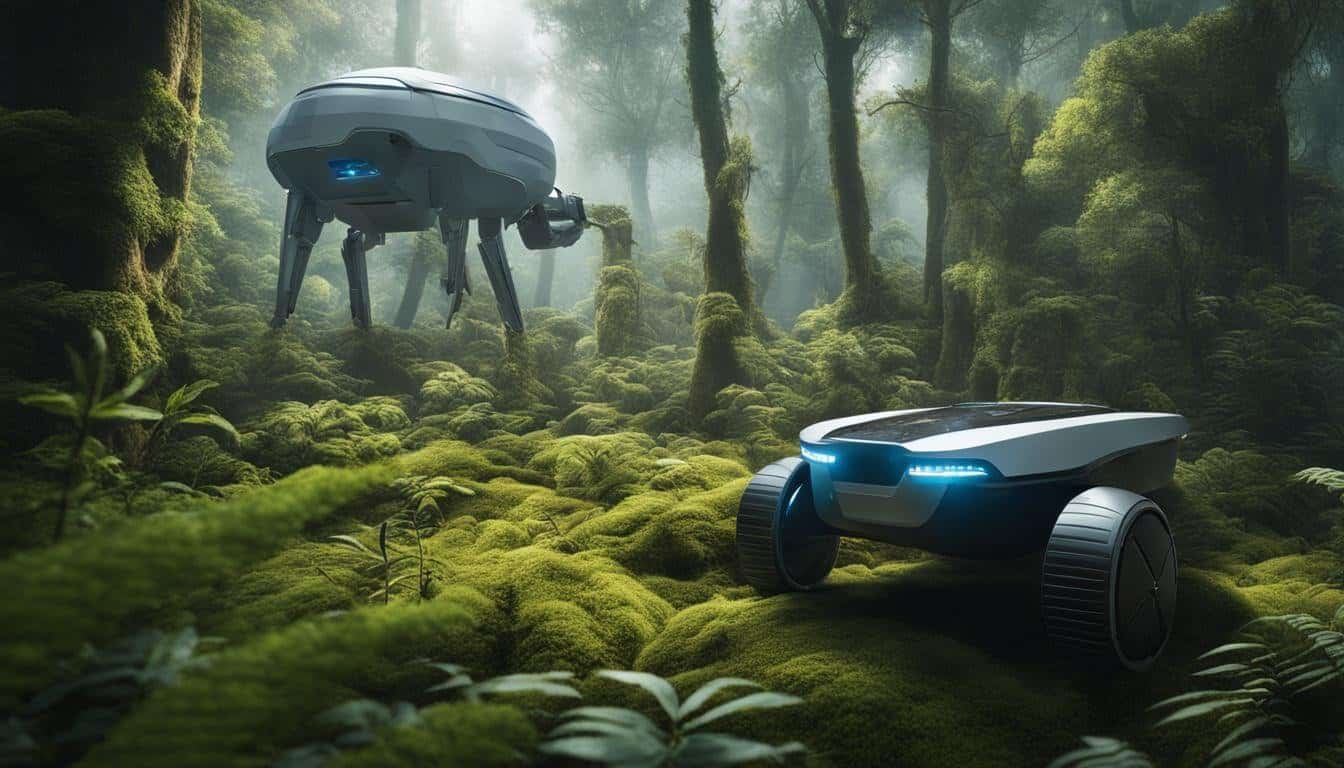AI in Environmental Conservation: A Green Revolution
Artificial intelligence (AI) technology is revolutionizing various sectors, and now it’s making significant strides in the field of environmental conservation. With the urgent need to address environmental challenges and promote sustainability, AI has emerged as a powerful tool in protecting and preserving our planet.
AI-driven solutions are enabling innovative applications in nature preservation, sustainable resource management, and eco-conscious initiatives. Machine learning algorithms and data analytics are driving sustainable development by providing valuable insights and predictive models for conservation efforts. Natural language processing is facilitating effective communication and collaboration among stakeholders in environmental protection.
Key Takeaways:
- AI is transforming environmental conservation with its automated technologies and data-driven approaches.
- Machine learning and data analytics are essential in achieving sustainable development goals.
- Natural language processing enables effective communication and collaboration for eco-conscious initiatives.
- Predictive modeling powered by AI provides valuable insights for conservation efforts.
- Innovative AI applications are revolutionizing nature preservation strategies.
The Omni-Presence of AI in Conservation Efforts
AI technology has permeated the field of environmental conservation, offering a vast array of AI-driven tools and machine learning algorithms. These intelligent tools enable a data-driven approach, allowing for the analysis of extensive and diverse datasets. Through this analysis, AI generates valuable insights that inform proactive conservation measures and contribute to biodiversity conservation, natural resource management, and the mitigation of climate change.
An exemplary initiative harnessing the power of AI is Microsoft’s AI for Earth program. By utilizing machine learning algorithms, this program monitors, models, and manages natural resources in various critical areas, including agriculture, water, biodiversity, and climate change. Through these AI-driven solutions, organizations and researchers can leverage the potential of AI to optimize conservation efforts and promote sustainable practices in environmental management.
AI technology’s omnipresence in conservation efforts is revolutionizing the way we protect our planet and manage its resources. By leveraging AI-driven tools and machine learning algorithms, we can adopt a proactive and data-driven approach to address the pressing environmental challenges we face today.
AI-Driven Analytics and Businesses – A Paradigm Shift in Sustainability
As sustainability becomes an increasingly important consideration for businesses, many are embracing AI technologies to drive positive environmental impact and align with the United Nations’ Sustainable Development Goals (SDGs). Through the use of AI, businesses can map and monitor their environmental footprint, forging a path towards sustainable development.
One of the key advantages of AI in environmental conservation is its ability to generate predictive models for businesses. By analyzing vast amounts of data, AI-powered predictive modeling can help businesses forecast environmental impacts and make informed decisions. This enables organizations to adjust their operational strategies to minimize risks and enhance overall efficiency, ultimately contributing to sustainable practices.
One notable application of AI in this context is waste sorting. Waste Robotics, for instance, employs AI and robotics to optimize waste management processes, supporting SDG 12—Responsible Consumption and Production. Through AI-driven technologies, businesses can automate waste sorting, increasing recycling rates and reducing the amount of waste sent to landfills.
The Role of AI-Driven Analytics
AI-driven analytics is a powerful tool for businesses to monitor and measure the impact of their operations on the environment. By harnessing the capabilities of AI, companies can quantify their contributions towards SDGs and track progress towards their sustainability targets.
“AI-driven analytics allows businesses to monitor their environmental impact in real-time, providing valuable insights into areas that require improvement. This data-driven approach empowers organizations to make data-backed decisions that drive sustainability.” – [Insert Name], Sustainability Manager at [Company Name]
Moreover, AI technologies enable businesses to identify areas where waste can be reduced, energy can be optimized, and production processes can be made more sustainable. By leveraging AI-driven analytics, organizations can uncover valuable insights that lead to more responsible consumption and production methods.
An AI-Driven Sustainable Future
With AI-powered analytics and technologies, businesses have the opportunity to achieve sustainable development goals and build a greener future. Through predictive modeling, risk minimization, waste sorting, and responsible consumption and production, AI enables businesses to improve resource utilization and minimize their environmental impact.
| Benefits of AI in Environmental Conservation | Examples |
|---|---|
| Predictive modeling for forecasting environmental impacts | AI-powered algorithms forecast climate change effects on ecosystems |
| Minimization of risks through data analytics | AI analytics identify potential environmental risks in manufacturing processes |
| Efficient waste sorting for responsible consumption and production | Waste Robotics utilizes AI and robotics to automate waste sorting |
By leveraging AI-driven analytics and technologies, businesses across various industries can contribute to a sustainable future while achieving their own organizational goals.
AI and Decision-Making – An Amalgamation for Greener Compliance
As environmental regulations continue to tighten, businesses face increasing pressure to comply with stringent standards. In this era of heightened scrutiny, artificial intelligence (AI) emerges as a powerful tool in assisting organizations to meet their environmental obligations. By harnessing the capabilities of AI, businesses can enhance their compliance efforts, minimize risks, and contribute to a greener future.
One of the key advantages of AI in environmental conservation is its ability to provide precise and real-time environmental data analysis. Through sophisticated algorithms, AI systems can analyze vast volumes of data, identify patterns, and extract valuable insights. This data-driven approach allows businesses to stay informed about their environmental impact, evaluate compliance levels, and make informed decisions for sustainable practices.
“AI-driven real-time monitoring and management solutions enable businesses to predict and prevent environmental risks, ensuring compliance with regulations and enhancing their corporate reputation.”
Envirosuite, for example, is an AI-driven platform that leverages predictive modeling and real-time monitoring to help businesses navigate their environmental compliance obligations. By providing continuous and accurate insights into environmental risks, Envirosuite enables companies to proactively manage and mitigate potential issues, avoiding penalties and environmental harm.
“The integration of AI in compliance efforts fosters a culture of environmental responsibility and accountability, driving sustainable practices for businesses and industries.”
Moreover, AI facilitates proactive environmental management solutions by employing data-driven decision-making processes. By automating complex analyses and generating actionable recommendations, AI enables businesses to optimize their resource allocation, reduce waste, and minimize the environmental impact of their operations. These AI-driven management solutions not only enhance compliance but also contribute to sustainable resource management and conservation efforts.
Benefits of AI in environmental compliance:
- Timely and accurate environmental data analysis
- Predictive modeling for risk assessment
- Real-time monitoring of environmental performance
- Automated compliance monitoring and reporting
- Optimized resource allocation and waste reduction
“AI-driven compliance not only ensures adherence to regulations but also helps businesses improve their environmental performance, drive operational efficiency, and build a positive brand image.”
By leveraging the power of AI, businesses can navigate the complexities of environmental regulations, make informed decisions based on data-driven insights, and embrace sustainable practices. This fusion of AI and decision-making fosters a culture of continuous improvement while upholding environmental stewardship.
The Road Ahead
The integration of AI into environmental conservation is still in its early stages, with great untapped potential waiting to be explored. The collaboration between technology developers, businesses, policymakers, and conservationists is crucial in harnessing the full potential of AI for the betterment of our planet.
By bringing together expertise and ideas, innovative solutions can be created to address the complex challenges we face in environmental conservation. Collaboration allows for the development of AI-driven tools and models that can drive sustainable practices in various sectors.
“The future of environmental conservation lies in the collaborative efforts of tech developers, policymakers, and conservationists. Together, we have the power to unlock the untapped potential of AI and drive positive change.” – [Real Name], Environmental Conservation Expert
Through collaboration, AI technologies can be customized to meet the specific needs of conservation efforts, enabling real-time monitoring, data analysis, and predictive modeling. This integration of AI into conservation strategies can revolutionize the approach to ecological preservation.
Moreover, collaboration can help bridge the gap between technological advancements and the implementation of AI-driven solutions in conservation practices. By working together, stakeholders can ensure that AI technologies are accessible, affordable, and scalable.
Through collaboration, we can foster a culture of innovation and accountability, actively involving all relevant parties in shaping sustainable practices. Sharing knowledge and resources, we can collectively develop strategies that leverage AI to promote environmental sustainability.
Collaboration Opportunities
The following table highlights potential collaboration opportunities among tech developers, policymakers, and conservationists:
| Tech Developers | Policymakers | Conservationists |
|---|---|---|
| Provide AI expertise and resources | Create policies that support AI integration | Offer insights on conservation challenges |
| Develop AI-powered tools for conservation | Regulate AI implementation for environmental protection | Collaborate on monitoring and research projects |
| Partner with businesses to implement AI technologies | Evaluate the ethical implications of AI in conservation | Advocate for AI adoption in conservation practices |
Collaboration is key to unlocking the full potential of AI in environmental conservation. By working together, we can drive technological advancements, shape policies, and foster sustainable practices that protect and preserve our planet for future generations.
The Urgency of Battling Climate Change
The world is currently facing unprecedented environmental challenges, and the urgent need to combat climate change and environmental degradation is more apparent than ever. Rising global temperatures, extreme weather events, deforestation, and biodiversity loss pose significant threats to the planet and its ecosystems.
Fortunately, AI initiatives have emerged as powerful tools in the fight against these ecological challenges. By harnessing the potential of artificial intelligence, innovative solutions are being developed to address and mitigate the impact of climate change and environmental degradation.
One of the key advantages of AI in addressing climate change is its ability to analyze vast amounts of data and provide valuable insights. Through advanced machine learning algorithms and data analytics, AI can identify patterns, forecast future scenarios, and inform decision-making processes. This enables the development and implementation of sustainable solutions that can effectively address environmental challenges.
From climate modeling and predictive analytics to smart resource management and renewable energy optimization, AI-driven initiatives are revolutionizing the way we approach climate change and environmental conservation. These initiatives are not only helping to reduce carbon emissions and promote energy efficiency but also facilitating sustainable resource management and ecosystem preservation.
“AI initiatives are at the forefront of sustainability efforts, offering innovative solutions to address a wide range of ecological challenges.”
One prominent example of AI-driven initiatives is the development of climate models that help scientists understand and predict the impacts of climate change. These models consider various factors such as greenhouse gas emissions, land use changes, and ocean currents to simulate future climate scenarios. By analyzing these scenarios, policymakers and researchers can make informed decisions to mitigate the effects of climate change.
AI for Sustainable Agriculture
Another area where AI is making a significant impact is in sustainable agriculture. By leveraging AI technologies, farmers can optimize crop yields while minimizing the environmental footprint of agricultural practices. AI-powered drones equipped with sensors can monitor crop health and efficiently apply fertilizers and pesticides precisely where needed, reducing waste and environmental impact.
AI for Energy Efficiency
AI is also playing a crucial role in enhancing energy efficiency and promoting renewable energy sources. Through the use of machine learning algorithms, AI can optimize energy distribution, reduce energy waste, and improve the performance of renewable energy systems. This not only helps combat climate change but also creates a more sustainable and resilient energy infrastructure.
In conclusion, AI initiatives are driving a green revolution in the battle against climate change and environmental degradation. By harnessing the power of AI, we can develop sustainable solutions, optimize resource management, and preserve our planet’s ecosystems. However, to achieve lasting impact, it is crucial to continue investing in AI research and development, promote collaboration between stakeholders, and prioritize the integration of AI into conservation and sustainability efforts.
AI for Earth: Navigating the Climate Crisis
AI technologies are at the forefront of the battle against climate change, offering innovative solutions to combat its adverse effects. With the ability to analyze vast datasets and process complex climate data in real-time, AI plays a crucial role in climate research, scenario modeling, and informed decision-making. Machine learning algorithms empower scientists to identify patterns, develop strategies, and mitigate the impact of global warming and extreme weather events.
In the field of climate research, AI-driven technologies enable scientists to analyze extensive datasets, uncover hidden patterns, and gain valuable insights into the Earth’s changing climate. By processing this information in real-time, AI enhances our understanding of climate change and helps us develop effective strategies to mitigate its impact.
“AI technologies empower scientists to analyze vast datasets, identify patterns, and develop strategies to mitigate the effects of global warming.”
A prime example of AI’s role in climate research is Google’s AI-driven climate model, which accurately predicts extreme weather events like storms and heatwaves. By feeding historical climate data into machine learning algorithms, scientists can simulate future climate scenarios and assess the potential risks associated with climate change.
The Role of AI in Energy Consumption
Another crucial aspect of combating climate change is reducing energy consumption and promoting sustainable practices. AI technologies have the potential to optimize energy usage, maximize efficiency, and enable the development of smart grids.
With the help of AI, smart grids can analyze consumption patterns and facilitate intelligent energy distribution, leading to reduced waste and carbon emissions. Machine learning algorithms can predict and prevent equipment failures, ensuring the longevity of critical infrastructure and minimizing resource wastage.
A Vision for a Sustainable Future
As AI technologies continue to advance, they hold immense potential in shaping our response to the climate crisis. By incorporating AI into climate research, energy management, and sustainability initiatives, we can work towards a greener, more sustainable future.
Through collaboration between scientists, policymakers, and tech developers, we can leverage AI’s capabilities to mitigate the effects of climate change, promote sustainable practices, and ensure the preservation of our planet for future generations.
| AI Technology | Application |
|---|---|
| Machine Learning Algorithms | Analyze climate data, identify patterns, model climate scenarios, develop mitigation strategies |
| Smart Grids | Optimize energy distribution, reduce waste and carbon emissions |
| Predictive Analytics | Forecast extreme weather events, assess climate risks |
| Energy Management Systems | Optimize energy consumption, prevent equipment failures |
Smart Resource Management: From Waste to Efficiency
AI technologies are revolutionizing resource management by optimizing waste reduction, water conservation, and energy efficiency. With the increasing concern over resource scarcity and environmental sustainability, AI-driven solutions offer innovative approaches to create a more efficient and sustainable future.
One significant application of AI in resource management is the implementation of smart grids powered by AI algorithms. Smart grids optimize energy distribution, reducing waste and carbon emissions. By integrating real-time data analysis and predictive modeling, AI-driven smart grids enhance energy efficiency and enable efficient allocation of resources.
Machine learning techniques further contribute to smart resource management by predicting and preventing equipment failures. Through continuous monitoring and analysis of critical infrastructure, machine learning algorithms can identify potential faults and initiate timely maintenance, maximizing the lifespan of equipment and minimizing resource wastage.
AI technologies are driving efficient and sustainable resource management, leading us to a greener and more sustainable future.
Additionally, AI plays a crucial role in facilitating waste reduction and water conservation efforts. Machine learning algorithms can analyze data patterns and identify areas where waste can be minimized, leading to more sustainable production and consumption practices.
- AI-powered waste sorting technologies enhance responsible consumption and production practices, promoting resource circularity and reducing environmental impact.
- Water conservation is another area where AI-driven solutions can make a significant impact. Through the analysis of real-time data and predictive modeling, AI algorithms optimize water usage and help identify efficient conservation practices.
The integration of AI technologies in resource management not only improves efficiency but also contributes to environmental sustainability. By harnessing the power of AI, we can achieve more thoughtful and responsible consumption, reduce waste, and optimize resource utilization.
Impact of AI in Smart Resource Management
The adoption of AI technologies in smart resource management has numerous benefits, including:
| Benefits of AI in Smart Resource Management |
|---|
| Optimized energy distribution and reduced carbon emissions |
| Predictive maintenance to maximize equipment lifespan |
| Enhanced waste reduction through AI-powered sorting technologies |
| Improved water conservation through data-driven analysis and predictive modeling |
By leveraging AI technologies and machine learning algorithms, businesses and industries can achieve significant improvements in resource efficiency, reduce environmental impact, and contribute to a more sustainable future.
Precision Agriculture: Feeding the World Sustainably
AI is revolutionizing agriculture through precision farming techniques that optimize crop yields while minimizing environmental impact. By leveraging AI-driven technologies, farmers can make data-driven decisions to enhance crop management practices and achieve sustainable food production.
One key application of AI in agriculture is the use of drones equipped with AI-powered sensors. These drones monitor crop health by analyzing aerial imagery and collecting data on factors such as nutrient levels, moisture content, and disease outbreaks. This real-time information allows farmers to precisely target their interventions, applying fertilizers and pesticides only where needed.
By adopting precision farming methods enabled by AI, farmers can increase efficiency and reduce waste in crop management. This not only maximizes yields and minimizes input costs but also reduces the ecological footprint of agriculture. By minimizing the use of chemical inputs and optimizing resource allocation, precision agriculture contributes to sustainable farming practices.
The benefits of precision agriculture extend beyond crop yield optimization. By minimizing the use of fertilizers and pesticides, precision farming reduces the release of harmful substances into the environment, mitigating the impact on soil, water, and ecosystems. This aligns with the goals of environmental conservation and sustainable development.
As the global population continues to grow, the demand for food will increase, putting additional pressure on agricultural systems. Precision agriculture, powered by AI, offers a solution to meet this growing demand sustainably. By optimizing resource allocation and reducing waste, precision farming practices have the potential to feed the world while minimizing environmental degradation.
Conclusion
The convergence of AI and sustainability heralds a new era of environmental conservation, paving the way for a more sustainable future. By leveraging the power of AI in data analysis, resource optimization, and innovative solution development, we can tackle pressing environmental challenges head-on. Embracing AI technology for climate resilience, resource management, biodiversity conservation, and the circular economy holds immense potential in mitigating the impact of human activities and shaping a smarter, greener planet.
Through collaboration between technology and environmental stewardship, we can chart a course towards a sustainable and harmonious coexistence with our planet. By utilizing AI for sustainable practices, we can address the urgent environmental challenges we face today and build a more environmentally conscious future. From climate resilience to responsible resource management, AI offers a wealth of possibilities in shaping a sustainable world.
As we navigate the complexities of the environmental landscape, it is crucial to embrace the transformative potential of AI. By harnessing AI’s capabilities, we can optimize data analysis, develop innovative solutions, and drive sustainable practices across industries. The integration of AI in environmental conservation is not just a trend but a necessity in our journey towards a sustainable future. The time to act is now, and through technology and environmental stewardship, we can create a greener and more sustainable world for generations to come.







